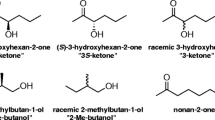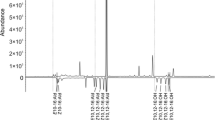Abstract
Female cabbage looper moths,Trichoplusia ni, from laboratory colonies initiated from three locations across the United States emitted similar quantities and blend ratios of the six known pheromone components. In contrast, females from a long-established laboratory colony emitted a greater proportion of four of the five minor components relative to the major component, (Z)-7-dodecenyl acetate; only the relative proportion of 11-dodecenyl acetate was similar in all of the populations sampled. Females from this population emitted (Z)-7-dodecenyl acetate at a rate similar to that from females from field-collected colonies. Within each population there were highly significant correlations among the quantities of pheromone components of similar molecular weights. Correlations between components of different molecular weights were not as great, but often were significant. Similarities of blend ratios among field populations may indicate that the chemical signal in this species is conservative. The difference of the blend ratios in our laboratory population from the other populations may indicate a decrease in the intensity of selection pressure that usually would maintain these values.
Similar content being viewed by others
References
Baker, T.C., Gaston, L.K., Pope, M.M., Kuenen, L.P.S., andVetter, R.S. 1981. A highefficiency collection device for quantifying sex pheromone volatilized from female glands and synthetic sources.J. Chem. Ecol. 7:961–968.
Berger, R.S. 1966. Isolation, identification and synthesis of the sex attractant of the cabbage looper.Ann. Entomol. Soc. Am. 59:767–771.
Bjostad, L.B., Gaston, L.K., andShorey, H.H. 1980. Temporal pattern of sex pheromone release by femaleTrichoplusia ni.J. Insect Physiol. 26:493–498.
Bjostad, L.B., Linn, C.E., Du, J.W., andRoelofs, W.L. 1984. Identification of new sex pheromone components inTrichoplusia ni, predicted from biosynthetic precursors.J. Chem. Ecol. 10:1309–1323.
Dunkelblum, E., Snir, R., Gothilf, S., andHarpaz, I. 1987. Identification of sex pheromone components from pheromone gland volatiles of the tomato looper,Plusia chalcites (Esp.).J. Chem. Ecol. 13:991–1003.
Haynes, K.F., andBaker, T.C. 1988. Potential for evolution of resistance to pheromones: Worldwide and local variation in chemical communication system of pink bollworm moth,Pectinophora gossypiella.J. Chem. Ecol. 14:1547–1560.
Haynes, K.F., Gaston, L.K., Pope, M.M., andBaker, T.C. 1984. Potential for evolution of resistance to pheromones: Interindividual and interpopulational variation in chemical communication system of pink bollworm moth.J. Chem. Ecol. 10:1551–1565.
Klun, J.A., andCooperators. 1975. Insect sex pheromones: Intraspecific variability ofOstrinia nubilalis in North America and Europe.Environ. Entomol. 4:891–894.
Krasnoff, S.B., andRoelofs, W.L. 1988. Sex pheromone released as an aerosol by the mothPhyrrharctia isabella.Nature 333:263–265.
Lanier, G.N., Birch, M.C., Schmitz, R.F. andFurniss, M.M. 1972. Pheromones ofIps pini (Coleoptera: Scolytidae): Variation in response among three populations.Can. Entomol. 104:1917–1923.
Lingren, P.D., Henneberry, T.J., andSparks, A.N. 1979. Current knowledge and research on movement of the cabbage looper and related looper species, pp. 394–405,in R.L. Rabb and G.G. Kennedy (eds.). Movement of Highly Mobile Insects: Concepts and Methodology in Research. University Graphics, North Carolina State University, Raleigh.
Linn, C.E., Bjostad, L.B., Du, J.W., andRoelofs, W.L. 1984. Redundancy in a chemical signal: Behavioral responses of maleTrichoplusia ni to a 6-component sex pheromone blend.J. Chem. Ecol. 10:1635–1658.
Löfstedt, C., Löfqvist, J., Lanne, B.S., Van Der Pers, J.N.C., andHansson, B.S. 1986. Pheromone dialects in European turnip mothsAgrotis segetum.Oikos 46:250–257.
McLaughlin, J.R., Mitchell, E.R., Chambers, D.L., andTumlinson, J.H. 1974. Perception of (Z)-7-dodecen-1-ol and modification of the sex pheromone response of male loopers.Environ. Entomol. 3:677–680.
Miller, J.R., andRoelofs, W.L. 1980. Individual variation in sex pheromone component ratios in two populations of the redbanded leafroller moth,Argyrotaenia velutinana.Environ. Entomol. 9:359–363.
Riordan, A.J. 1979. Density and availability of meteorological data and their use in illustrating atmospheric long-range transport in the Southeastern United States, pp. 120–131,in R.L. Rabb and G.G. Kennedy (eds.). Movement of Highly Mobile Insects: Concepts and Methodology in Research. University Graphics, North Carolina State University, Raleigh.
Ryan, M.J., andWilczynski, W. 1988. Coevolution of sender and receiver: Effect on local mate preference in cricket frogs.Science 240:1786–1788.
Schal, C., andCardé, R.T. 1985. Rhythmic extrusion of pheromone gland elevates pheromone release rate.Experientia 41:1617–1619.
Shorey, H.H., andHale, R.L. 1965. Mass-rearing of the larvae of nine noctuid species on a simple artificial medium.J. Econ. Entomol. 58:522–524.
Tumlinson, J.H., Mitchell, E.R., Browner, S.M., Mayer, M.S., Green, N., Hines, R. andLindquist, D.A. 1972.cis-7-Dodecen-1-ol, a potent inhibitor of the cabbage looper sex pheromone.Environ. Entomol. 1:354–358.
Author information
Authors and Affiliations
Rights and permissions
About this article
Cite this article
Haynes, K.F., Hunt, R.E. Interpopulational variation in emitted pheromone blend of cabbage looper moth,Trichoplusia ni . J Chem Ecol 16, 509–519 (1990). https://doi.org/10.1007/BF01021782
Received:
Accepted:
Issue Date:
DOI: https://doi.org/10.1007/BF01021782




